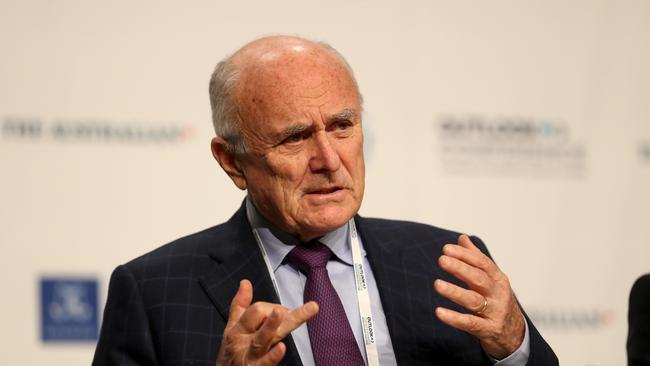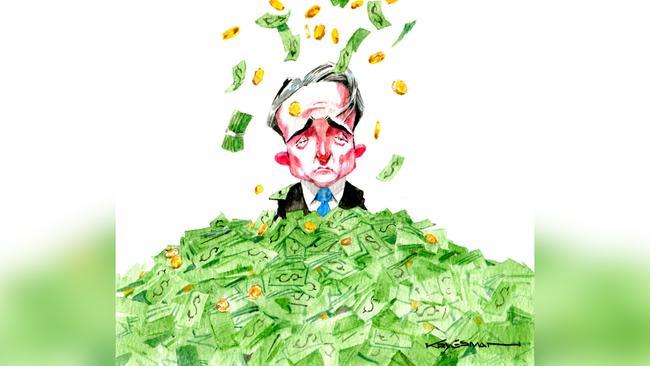
In the wake of last week’s ACCC Suncorp rejection, the ANZ argued that the strength of CBA underlined the need for it to build scale.
No disputes on this score, given CBA’s 25 per cent market share is just under the 27 per cent combined ANZ and NAB home loan share, but the issue is how ANZ builds scale and how customers benefit.
The big four on CBA’s figures control 72 per cent of the home loan market. ANZ can use its profits to spend $4.9bn buying another 2 per cent market share with Suncorp, overcoming its underweight position in Queensland, or it could use the money and technology to actually compete in the market.
The former approach is more welcome for Comyn and his big four comrades because it would be less disruptive.
That in essence is what the ACCC debate is about. It remains to be seen which way Australian Competition Tribunal president Michael O’Bryan decides.
Better operating performance does work, as the accompanying table shows, with CBA outperforming the overall stockmarket by 1740 per cent since early 2000, coming from a distant second to NAB to lead the pack, double the size of NAB and bigger than a combination of any of its “competitors”.

ANZ has yet to formally lodge an appeal against last week’s ACCC ruling. Once it does the tribunal has 90 days to decide.
As noted last week, ANZ wrongly chose to seek clearance via the authorisation route, which requires the ACCC to be satisfied there is no lessening of competition, rather than the informal route where it’s the ACCC that must prove a substantial lessening. This reversed onus of proof is important – and corporate Australia will have to get used to it if ACCC chief Gina Cass-Gottlieb is successful in changing the merger rules.
Her formula is presently before the government after being lodged early this year.
The co-ordination effects of a consolidated market, the subject of economic textbooks for all of this century and more, is where the concerns lay.
The theory is a consolidated market allows price co-ordination without the need for backroom deals because everyone involved knows the dangers of competition and some gentle price signalling does the trick. This is evident throughout much of the economy and certainly in banking, insurance, telecoms and aviation.
The best policy response is more competition, which is best achieved by stopping more consolidation.
True competition is more effective than price controls, which is where the ACTU-led price-gouging publicity stunt led by Alan Fels may head.
Fels is a strong advocate for merger reforms, including divestment powers, and the arguments already made in parliamentary committee hearings are sure to be repeated.
Under authorisation, clearance can be granted if there is public benefit flowing from the deal, which is almost impossible for a big bank to claim.
Suncorp’s behaviour in the general insurance market, which is essentially a duopoly, is a perfect example of why the ACCC is concerned about further consolidations in banking.
Suncorp’s car insurance premium income rose 15.6 per cent last year on a 2.1 per cent increase in policies, and home insurance premiums rose 11.4 per cent on a 0.6 per cent increase in policies.
Costs may have risen but pricing power is clear.
CBA closes gap
CBA is used to claiming No.1 spots on most bank metrics but still concedes it is lagging behind NAB in business bank lending.
The gap is closing, with CBA up from $103bn in 2020 to $131.5bn in 2023, against NAB at $137bn.
NAB is yet to report full-year numbers.
CBA this week trumpeted its No.1 net promoter score in business lending, but further into the results presentation it confided market shares have not increased since June 2019. This is despite growing at 1.4 times system last year, adding an additional $14.5bn in loans.
There are some definitional issues, but it seems the CBA machine continues to make ground, boosted by metrics like being the most favoured financial institution at 25 per cent against 19 per cent for NAB.
CBA has more merchant networks, 25.4 per cent of customers, and 90 per cent of business loans are going to customers with transaction accounts with the bank.
Lending is obviously the most important metric and NAB’s stranglehold on small business lending is so far untouched by the albeit impressive efforts of Mike Vacy-Lyle and his team at CBA business bank.
CBA is growing faster than system, and it seems just a matter of time before Vacy-Lyle can be declare victory.
Brookfield optimism
Momentum has swung towards Brookfield gaining ACCC clearance on its $18.7bn takeover of Origin, in part because it agreed to a one-month extension for consideration of the bid.
The regulator has taken a more lenient stance on behavioural undertakings, as shown by the clearance of the Linfox merger with Prosegur back in June.
Brookfield’s promise to spend $25bn to build 14GW of renewable generation and storage is unenforceable once the deal goes through. But it is being transacted through the Brookfield Global Transition Fund, which has a dual mandate: to deliver financial returns and reduce emissions.
The ACCC is taking this as a commitment Brookfield must keep, or it would breach the terms of the fund and lose face.
Still the old ACCC would normally have preferred structural undertakings or at the very least enforceable behavioural undertakings.
Chair Gina Cass-Gottlieb will take part in this decision, having recused herself from the ANZ-Suncorp deal, but enforcement boss Liza Carver who advised Brookfield on the Pacific National takeover is sitting this one out.
BlueScope confidence
BlueScope’s Mark Vassella has underlined his confidence about steel building frames and roof tiling, as shown by Friday’s commitment to a $415m expansion of its metal coating capacity in Erskine Park in Sydney.
The market is soft now but in the last boom the company was forced to import from its Vietnam mill to meet demand and consequently pay dumping duties on its own complaints.
Timber accounts for 85 per cent of home frames and every 1 per cent is equivalent to an extra 8000 tonnes of steel.
Vassella has already issued definitive forecasts for the 2023 financial year, so when he fronts the market attention will be on his outlook statement, which is expected to be downbeat.
Next month, the company will update its ESG plans, which takes on more importance for a big polluter like BlueScope.
Still to come is word on the penalty faced by the company for last year’s ruling it attempted to fix prices back in 2013-14, and on the fate of former executive Jason Ellis. The company can’t appeal the decision until the penalty is awarded after the April 3 penalty hearing.




In the midst of a cost of living crisis, Commonwealth Bank’s record $10.2bn profit understandably meant Matt Comyn focused much of his results pitch on Canberra and the media, to explain the need for strong banks.